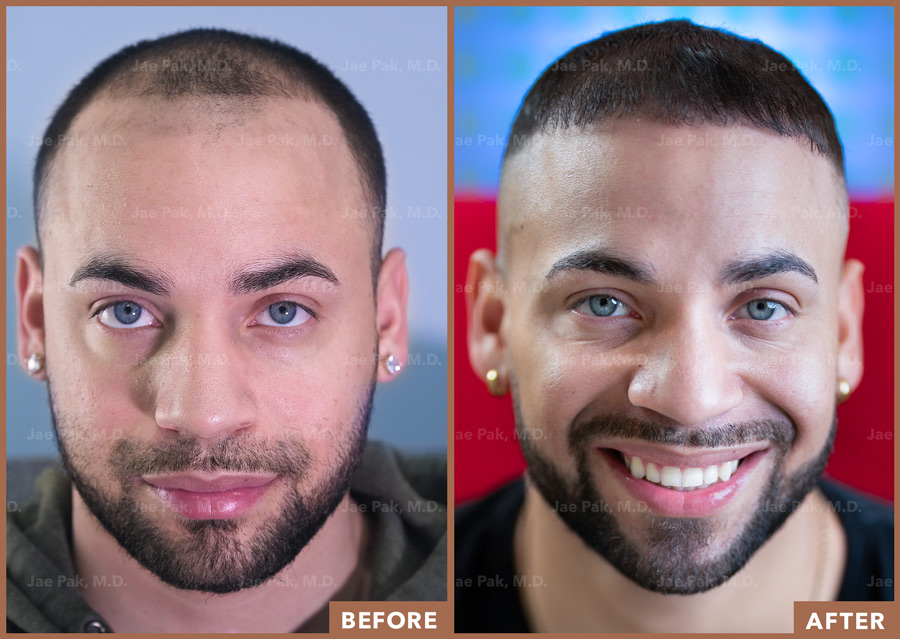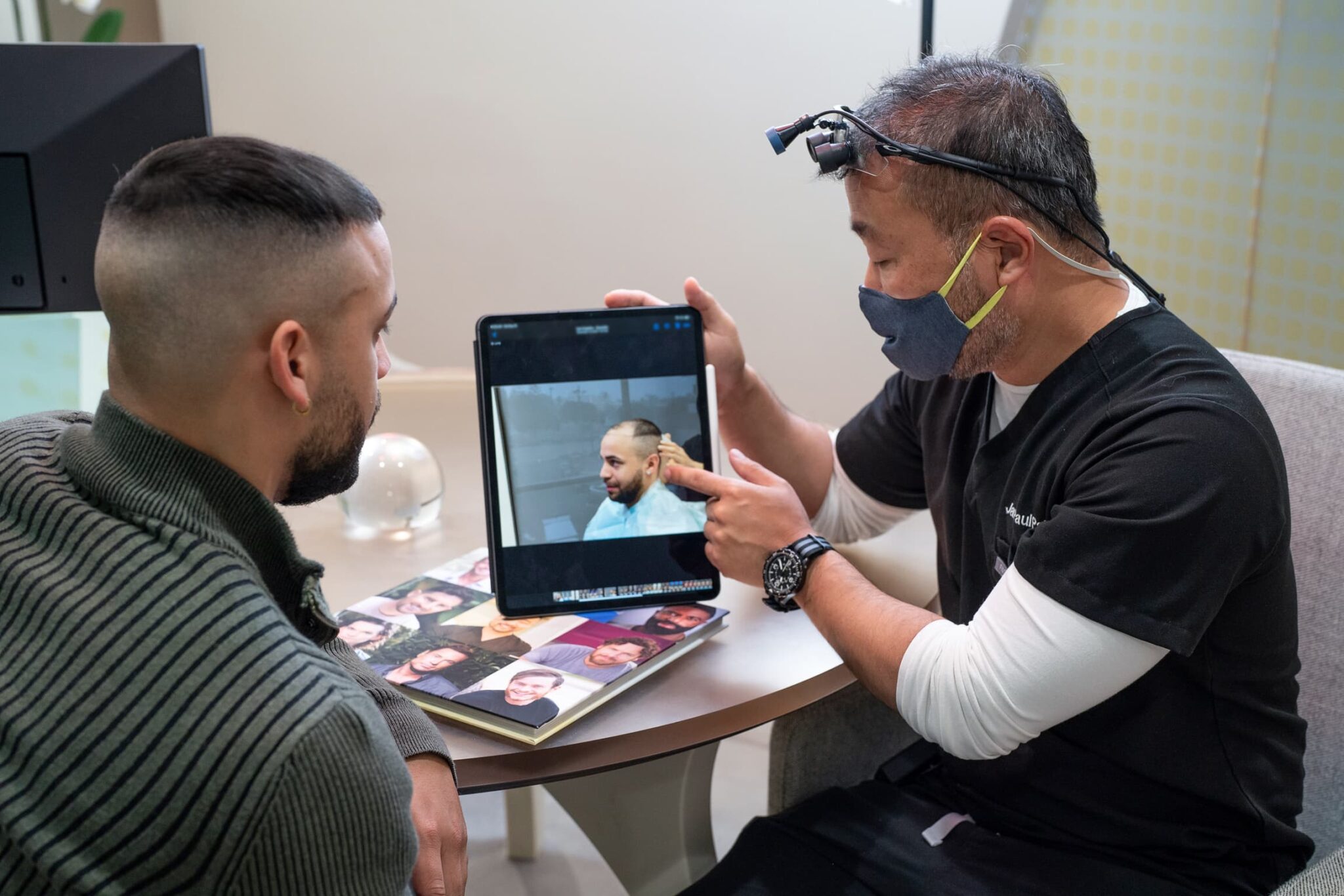
Actual Patient of Jae Pak, M.D.
Every day, millions of people look in the mirror and make a crucial realization – the hair on their scalp is not where it used to be, and something needs to be done.
Hair loss is not a modern phenomenon by any means. For thousands of years, humankind has dealt with the problem, and even ancient records show that physicians of their time made noble attempts to address the affliction.
Thankfully, we’re living in a golden age of medical treatment with numerous hair restoration solutions available to the public. It’s not a matter of whether a bad hairline can be fixed, but rather how much you’re willing to commit to a solution.
Yes, hairlines can be fixed, even in advanced stages of balding, but many variables come into play. In this article, let’s talk about the process of fixing a bad hairline from beginning to end, and set realistic expectations for results, timelines, cost, and more.
To solve any sort of problem, medical or otherwise, we must begin with an honest assessment of the situation. Only when we acknowledge the situation in full can we understand the core problem and start working towards solutions.
Here are three points to help you navigate the initial stages of your hair restoration journey.
A look in the mirror is not sufficient to make a complete assessment of hair loss, and you don’t want to rely on the opinions of friends or family to get the truth about your hairline.
Instead, we encourage clients to take an objective viewpoint when assessing their level of hair loss, meaning 360-degree photos from every angle, including top-down shots with proper lighting and clarity.
We also suggest keeping a record of hair loss progression if you suspect thinning in the early stages, including taking note of excess shedding on the pillow, in the shower, wearing hats, or performing a strenuous activity at work or during exercise.
If you need a point of reference in this process, turn to the Norwood-Hamilton scale of male pattern baldness. This can also help you predict the future progression of hair loss based on years of field research.
It’s not enough to glance at your hairline and declare a self-diagnosis on the spot. Do your best to take a scientific approach and assess your level of hair loss realistically.
Even with the insight of the Norwood-Hamilton scale, the trend of pattern balding is hard to predict on an individual level.
Some men experience early minor hair loss in the form of the M-shaped hairline and thinning on the temples but will not see advancement into further stages.
Other men will not notice thinning until they reach their 40s or 50s but then suffer rapid hair loss on the front of the scalp and vertex in the span of a few months.
While it can help to understand the progression of balding in other members of your family, we must recognize that hair loss is an individual issue requiring custom solutions.
The progression and severity of hair loss may vary greatly between patients. Still, one thing remains universally true across the board – early action and prevention are your best chance at fixing a bad hairline from the start.
Whether it’s topical treatments like Minoxidil, once-a-day pills like Finasteride, or any type of therapeutic treatment to stimulate hair growth naturally, fixing a bad hairline depends greatly on how quickly you assess, strategize, and execute a plan.
As we talk through the various types of treatment for hair restoration, keep this point in mind, and let it be a reminder that hair loss must be addressed sooner than later for optimal results.
With a vigilant stance on hair loss assessment and understanding of common progression patterns, have a look at a few non-surgical options for hair health and restoration before considering the surgical route.
The importance of a healthy lifestyle cannot be overstated for the maintenance of strong hair and prevention against hair loss.
Proper nutrition, exercise, sleep hygiene, and stress reduction are vital components of a healthy body and mind, ensuring proper blood flow and hormone balance in the scalp.
Many hair specialists suggest taking supplements if daily nutrient requirements are not met, including proteins like collagen and biotin for hair strength and longevity.
Lavender, tea tree, peppermint, and rosemary are among the most popular essential oils for healthy hair, to be administered with a carrier oil like coconut or castor.
Many shampoos and conditioners can be found with similar ingredient profiles, in addition to compounds like zinc, magnesium, and even caffeine.
If patients suffer dandruff or flaking on the scalp, medicated shampoos may help promote scalp health and prevent hair loss as a result.
Only two medications – Minoxidil and Finasteride – have been approved by the FDA to treat hair loss in a clinical capacity.
While Minoxidil is a topical treatment meant to boost blood flow and nutrient intake in the scalp, Finasteride acts as a DHT blocker that inhibits compounds that interact negatively with hair growth cycles in men.
Sometimes, both drugs are prescribed for simultaneous use for male patients by hair loss doctors. However, any hair restoration results will be lost and returned to baseline when either medication is discontinued.
A range of promising alternative therapies for hair regrowth from low-level light exposure to platelet-rich plasma and microchanneling have emerged in just the past decade or so.
The advantage of these therapies is that they’re non-invasive, with a low risk of side effects and potential for outstanding results.
However, the cost of these treatments can add up over time, and clients must commit to ongoing upkeep to ensure the best results in the long term.
The outcome of these treatments may not be permanent but could prove helpful in combination with other medications or post-surgery care.
For a definitive fix to a bad hairline, restorative surgery is by far the most effective option.
These procedures are costly and time-consuming with considerable downtime, but they deliver the most transformative and permanent results when done correctly.
Here are the best modern options for restorative hairline surgery.
Also known as strip surgery, FUT works by extracting a linear portion of hair-bearing skin from the donor area of the patient’s scalp.
Follicle units are then dissected, prepared, and implanted to the target area of the hairline and vertex with tiny incisions, allowing them to take root and grow back as real, healthy hair.
FUE is a newer method of hair harvesting whereby surgeons extract individual follicle units from the donor area rather than using the strip skin method.
Harvesting large quantities of healthy hair is more difficult with FUE, but the procedure has the advantage of leaving no linear scar on the back of the head. FUE also tends to be more costly than FUT.
SMP is a relatively new procedure gaining traction in the cosmetic surgery field.
A comprehensive “hair tattoo” is performed with thin, high-precision needles to give the appearance of close-shaved hair on the scalp. SMP results are permanent and require minimal maintenance and upkeep compared to organic solutions.
Envision your new hairline today. Schedule a consultation with Dr. Pak to see if hair restoration is right for you.
Request a Consultation
Anyone who has experienced hair loss knows what a frustrating experience it can be, and we’ve all searched for that one piece of the puzzle that represents the missing link.
The purpose of this article is not to have you looking for that “turnkey solution” to hair restoration but instead to show you that results are possible with a comprehensive strategy — including elements of all the treatments we’ve described so far.
In other words, it won’t be a particular shampoo, supplement, or topical medication that fixes your hairline in an overnight miracle. It may take several drugs, therapies, and maybe even a surgical procedure to attain the results you envision.
Our goal is not to discourage you from pursuing your hair restoration goals. Many people have accomplished this feat before, and with far less technology and guidance.
To fix a bad hairline takes commitment and a big-picture understanding of what’s possible.
We encourage patients to take hair loss seriously from the start, establish an entire plan with a trusted hair loss specialist, and tackle the problem from multiple angles to maximize their chances of success.
Again, the process may cost time and money, but to fix your hairline in full and achieve the look you want, the effort is well worth it.
Sources:
Signs of Balding 101 | Man Matters
Male Pattern Baldness | Medline Plus
Medical Treatments for Balding in Men | American Family Physician
Speak with Jae Pak, M.D. today!
Request a Consultation